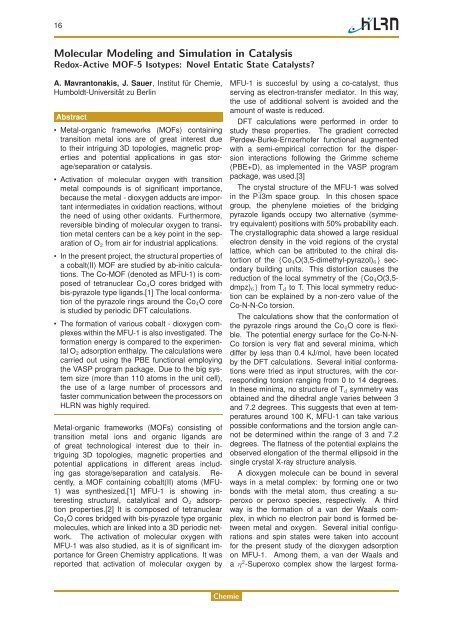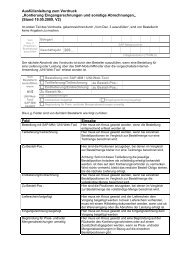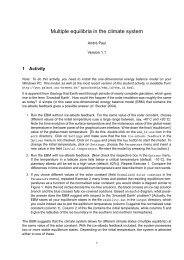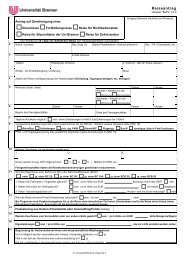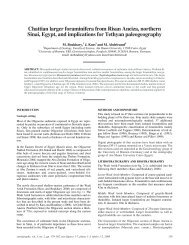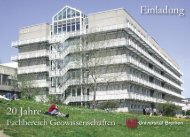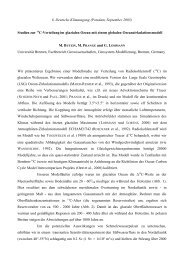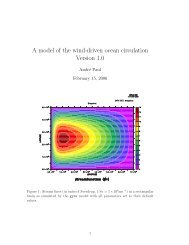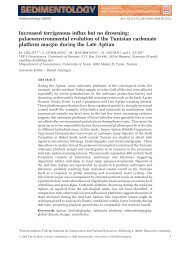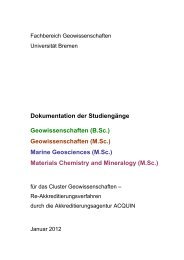Forschung im HLRN-Verbund 2011
Forschung im HLRN-Verbund 2011
Forschung im HLRN-Verbund 2011
- Keine Tags gefunden...
Erfolgreiche ePaper selbst erstellen
Machen Sie aus Ihren PDF Publikationen ein blätterbares Flipbook mit unserer einzigartigen Google optimierten e-Paper Software.
16Molecular Modeling and S<strong>im</strong>ulation in CatalysisRedox-Active MOF-5 Isotypes: Novel Entatic State Catalysts?A. Mavrantonakis, J. Sauer, Institut für Chemie,Humboldt-Universität zu BerlinAbstract• Metal-organic frameworks (MOFs) containingtransition metal ions are of great interest dueto their intriguing 3D topologies, magnetic propertiesand potential applications in gas storage/separationor catalysis.• Activation of molecular oxygen with transitionmetal compounds is of significant <strong>im</strong>portance,because the metal - dioxygen adducts are <strong>im</strong>portantintermediates in oxidation reactions, withoutthe need of using other oxidants. Furthermore,reversible binding of molecular oxygen to transitionmetal centers can be a key point in the separationof O 2 from air for industrial applications.• In the present project, the structural properties ofa cobalt(II) MOF are studied by ab-initio calculations.The Co-MOF (denoted as MFU-1) is composedof tetranuclear Co 4 O cores bridged withbis-pyrazole type ligands.[1] The local conformationof the pyrazole rings around the Co 4 O coreis studied by periodic DFT calculations.• The formation of various cobalt - dioxygen complexeswithin the MFU-1 is also investigated. Theformation energy is compared to the exper<strong>im</strong>entalO 2 adsorption enthalpy. The calculations werecarried out using the PBE functional employingthe VASP program package. Due to the big systemsize (more than 110 atoms in the unit cell),the use of a large number of processors andfaster communication between the processors on<strong>HLRN</strong> was highly required.Metal-organic frameworks (MOFs) consisting oftransition metal ions and organic ligands areof great technological interest due to their intriguing3D topologies, magnetic properties andpotential applications in different areas includinggas storage/separation and catalysis. Recently,a MOF containing cobalt(II) atoms (MFU-1) was synthesized.[1] MFU-1 is showing interestingstructural, catalytical and O 2 adsorptionproperties.[2] It is composed of tetranuclearCo 4 O cores bridged with bis-pyrazole type organicmolecules, which are linked into a 3D periodic network.The activation of molecular oxygen withMFU-1 was also studied, as it is of significant <strong>im</strong>portancefor Green Chemistry applications. It wasreported that activation of molecular oxygen byMFU-1 is succesful by using a co-catalyst, thusserving as electron-transfer mediator. In this way,the use of additional solvent is avoided and theamount of waste is reduced.DFT calculations were performed in order tostudy these properties. The gradient correctedPerdew-Burke-Ernzerhofer functional augmentedwith a semi-empirical correction for the dispersioninteractions following the Gr<strong>im</strong>me scheme(PBE+D), as <strong>im</strong>plemented in the VASP programpackage, was used.[3]The crystal structure of the MFU-1 was solvedin the P43m space group. In this chosen spacegroup, the phenylene moieties of the bridgingpyrazole ligands occupy two alternative (symmetryequivalent) positions with 50% probability each.The crystallographic data showed a large residualelectron density in the void regions of the crystallattice, which can be attributed to the chiral distortionof the {Co 4 O(3,5-d<strong>im</strong>ethyl-pyrazol) 6 } secondarybuilding units. This distortion causes thereduction of the local symmetry of the {Co 4 O(3,5-dmpz) 6 } from T d to T. This local symmetry reductioncan be explained by a non-zero value of theCo-N-N-Co torsion.The calculations show that the conformation ofthe pyrazole rings around the Co 4 O core is flexible.The potential energy surface for the Co-N-N-Co torsion is very flat and several min<strong>im</strong>a, whichdiffer by less than 0.4 kJ/mol, have been locatedby the DFT calculations. Several initial conformationswere tried as input structures, with the correspondingtorsion ranging from 0 to 14 degrees.In these min<strong>im</strong>a, no structure of T d symmetry wasobtained and the dihedral angle varies between 3and 7.2 degrees. This suggests that even at temperaturesaround 100 K, MFU-1 can take variouspossible conformations and the torsion angle cannotbe determined within the range of 3 and 7.2degrees. The flatness of the potential explains theobserved elongation of the thermal ellipsoid in thesingle crystal X-ray structure analysis.A dioxygen molecule can be bound in severalways in a metal complex: by forming one or twobonds with the metal atom, thus creating a superoxoor peroxo species, respectively. A thirdway is the formation of a van der Waals complex,in which no electron pair bond is formed betweenmetal and oxygen. Several initial configurationsand spin states were taken into accountfor the present study of the dioxygen adsorptionon MFU-1. Among them, a van der Waals anda η 2 -Superoxo complex show the largest forma-Chemie


